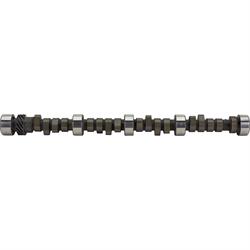Camshaft Selection Explained
How to Pick a Camshaft
There are many variables that will affect how a camshaft will perform in your engine. Before you even start comparing numbers, it’s important to understand camshaft design at the fundamental level. Once you have a better understanding of how each number affects the performance of your engine, selecting the right camshaft becomes less of a guessing game and more of a knowledge-based decision.
Picking The Right Camshaft
There’s no doubt whether it’s daily driven or street and strip, most hot rodders want their street machines to sound the part. Nothing beats the syncopated music of a choppy idle when you’re pulling up to a traffic light. It’s more of a side-effect that race engines sound like this because their needs rely on high rpm operation. To run at higher rpm their camshafts need to be ground with a higher lift and longer duration. More valve lift and duration will obviously increase rpm, but on a street car one of the most common mistakes is choosing a camshaft that is poorly matched for the engine. The art of matching a camshaft may come easier with experience, but it all comes down to finding the right balance between performance and drivability.
Roller Camshaft versus Flat Tappet Camshaft
What To Consider When Selecting A Camshaft
Most street performance cams will range between .450 and .550-inches of lift. But as you climb up to more radical profiles, say .460-inches and up, you should also consider what your budget needs are for the project. To prevent coil bind, changes in clearance, or part failure, high lift camshafts will require an upgrade to the original valve springs, rocker arms and pushrods. If you have power brakes that require vacuum at idle, or a stock transmission and converter, a high lift cam probably won’t perform the best for you. On a near to stock engine a camshaft around .450-inches of lift, 110 degrees of lobe separation and .218 duration at .050-inch lift should still give you a choppy idle while maintaining strong vacuum at idle.
The right camshaft involves much more than just matching valvetrain components and other engine parts. The entire sum of the vehicle is just as important. Most camshaft manufacturers will list the optimum rpm range on each camshaft. But as you’re matching the rpm range you should also consider what your intentions are for the car. The type of transmission and torque converter, the vehicle weight, compression ratio, tire size, and rear-end gear ratio will all affect the rpm characteristics. So it’s important to know what kind of car you’re planning to build from the start.
Expert Cam Recommendations
We consulted our tech experts at Speedway and asked what they would recommend on a ‘32 Ford street rod and a ’55 Chevy. The ’32 Ford weighed in at around 2800lbs with a 350 cubic-inch engine at 9:1 compression, a TH350 transmission with a 2200rpm stall and 3.50:1 rearend gear ratio. They recommended going with relatively mild street cam like a Comp 260H grind, which has a .440-inch lift, 212-degrees duration at .050-inch lift and 110 degrees of lobe separation. The ’55 Chevy weighed in at about 3,350lbs and ran a 383 engine with 10.5:1 compression. Using a TH350 transmission with a 3000 – 3500rpm stall, and 4.11:1 rearend gear ratio they recommended using a Comp 292H grind, which has a .501-inch lift, 244 duration at .50-inch lift and 110 degrees of lobe separation.



